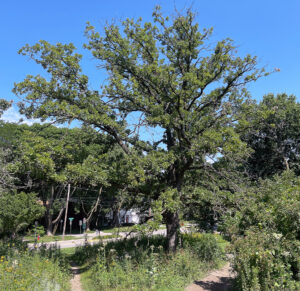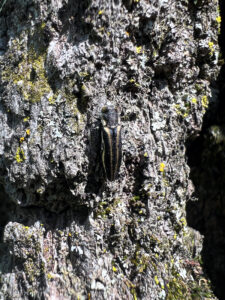
A bur oak more than 100 years old exhibits canopy dieback and epicormic branching caused by twolined chestnut borer. / Photo Credit: Wisconsin DNR
By Michael Hillstrom, DNR Forest Health Specialist, Fitchburg
Michael.Hillstrom@wisconsin.gov
White, red and bur oaks have been experiencing increased mortality in Wisconsin and neighboring states over the last few years.
The causes of mortality are varied, but two-lined chestnut borer (TLCB) is the most common culprit. Wisconsin has switched from a period of historically wet years (2017-2020) to drought conditions that have become more severe each year (2021-2023). Add in frost damage, storm damage, increased growing season length and aging forests and the environmental recipe exists for stressed oaks that are more susceptible to attack by insects and diseases.

An adult twolined chestnut borer, mostly black with two gold stripes on its wing covers. / Photo Credit: Wisconsin DNR
Oak wilt certainly remains an issue, primarily for red oaks, but in many cases the recent increased oak mortality is the result of environmental stressors, insects and fungi.
Here are a few of the common situations which can lead to oak mortality:
- Drought-stressed oaks that were defoliated by spongy moth, oak leafroller and/or other caterpillars. Those conditions have been enough to kill stressed trees or make them susceptible to mortality from TLCB and Armillaria. Oak trees defoliated by spongy moth should have produced new leaves in three to four weeks if they were healthy. Oaks that were defoliated but did not produce new leaves usually will not recover the following year.
- Landscape oaks, oaks on forest edges and recently thinned oak stands that are hit hardest by drought and often have ground disturbance or soil compaction.
- Stressed white and bur oaks, 80 or more years old, being killed by TLCB, armillaria and potentially root pathogens such as phytophthora.
- Even generally healthy oaks stands are seeing mortality of poor condition and suppressed trees from drought, insects and fungi.
It’s important to note that stress events such as droughts often lead to mortality events caused by TLCB and Armillaria, both native species. Trees that are attacked by TLCB and Armillaria during a stress event may be killed quickly or may die over the next one to three years. As always, proper forest management is the best solution. Well cared-for forests are better able to survive stressful environmental conditions.
However, given the current drought conditions, the best option may be to avoid forestry work in oaks stands for a few years until they have a chance to recover. This recommendation is consistent with the spongy moth forest management guidelines, but applies to many situations that put oaks under significant stress, such as drought. If salvage harvesting will be conducted, do so only during frozen ground conditions to avoid causing additional stress within a stand.
For yard or other high-value oaks, simply watering them low and slow (about 1 inch per week) during the growing season often is the best option to keep them healthy and help them recover from stress events. Mulching is another good option.
It is also important to avoid injury and ground disturbance. Certified arborists may be able to protect healthy oaks with insecticides and fungicides, but oaks with significant canopy dieback or epicormic branching (shoots rising from buds lying under the bark of a trunk, stem or branch of the tree) are unlikely to recover and should be removed if they pose a hazard.
